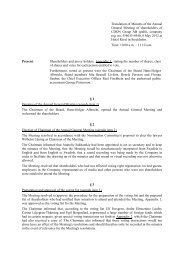Annual Report 2010 - CDON Group
Annual Report 2010 - CDON Group
Annual Report 2010 - CDON Group
You also want an ePaper? Increase the reach of your titles
YUMPU automatically turns print PDFs into web optimized ePapers that Google loves.
<strong>CDON</strong> <strong>Group</strong> AB<br />
<strong>Annual</strong> Årsredovisning report <strong>2010</strong> <strong>2010</strong><br />
Presentation of the financial statements<br />
The IASB’s annual improvements that were published in May <strong>2010</strong> changed the requirements of IAS 1 Presentation of Financial<br />
Statements regarding the presentation of the statement of changes in equity. The company has elected to implement these changes<br />
early, starting with the <strong>2010</strong> annual report. The changes mean that reconciliation of the year’s change in each component of equity<br />
in the statement of changes in equity, such as reserves for accumulated other comprehensive income, do not need to specify each<br />
item of other comprehensive income. The company has, as permitted under this amendment, chosen to provide information with<br />
such detailed reconciliation of reserves and other components of equity in the notes instead of in the statement of changes in<br />
equity. Such detailed reconciliation was also provided in the notes of the 2009 annual report, but appears to be required in the<br />
statement of changes in equity under the version of IAS 1 that applies to <strong>2010</strong>, without said early adoption. Though, in accordance<br />
with the wording of the amended IAS 1, the previous year’s comprehensive income line item has been split up with separate<br />
specification of profit/loss for the year and other comprehensive income for the year in the statement of changes in equity. The<br />
presentation changes apply to the current year and the comparative year. The changes did not result in any adjustments to amounts<br />
in the financial statements.<br />
2.1.2 New IFRSs that have not yet been implemented<br />
Several new or amended IFRSs will not go into effect until coming financial years and were not adopted early in preparing these<br />
financial statements. New standards or amendments effective for future financial years will not be adopted early.<br />
As of 2013, the new IFRS 9 Financial Instruments is intended to replace IAS 39 Financial Instruments: Recognition and Measurement.<br />
IFRS 9 may not be applied as it is not approved yet by the EU. Its effect on the <strong>Group</strong> is considered insignificant.<br />
These changes in accounting policies with future application should not have any effect on the consolidated financial statements:<br />
- Amendments to IAS 24 Related Party Disclosures, mainly regarding information on government-related companies, but also on<br />
the definition of related parties<br />
- Amendments to IAS 32 Financial Instruments: Presentation, regarding presentation of new share issues<br />
- Amendments to IFRS 7 Financial Instruments: Disclosures, regarding new disclosure requirements for transferred financial<br />
assets<br />
- Amendments to IFRIC 14/IAS 19 The Limit on a Defined Benefit Asset, Minimum Funding Requirements and their Interaction,<br />
regarding advance payments to cover minimum funding requirements<br />
- IFRIC 19 Extinguishing Financial Liabilities with Equity Instruments<br />
- <strong>Annual</strong> improvements to IFRSs that are not already adopted, especially among those published in May <strong>2010</strong><br />
2.2 Classification<br />
Non-current assets and non-current liabilities are essentially expected to be recovered or paid 12 months or more after the<br />
reporting date. Current assets and current liabilities essentially comprise amounts expected to be recovered or paid within 12<br />
months of the reporting date.<br />
2.3 Operating segment reporting<br />
An operating segment is a <strong>Group</strong> entity that engages in activities that may earn revenue and incur expenses, and for which separate<br />
financial information is available. Operating segment earnings are reviewed by the Company’s executive management to assess<br />
performance and allocate resources to the segment. See Note 4 for more information on the division and presentation of operating<br />
segments.<br />
53




